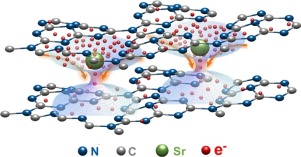Applied Catalysis B: Environment and Energy ( IF 20.2 ) Pub Date : 2018-03-19 , DOI: 10.1016/j.apcatb.2018.03.054 Xing’an Dong , Jieyuan Li , Qian Xing , Ying Zhou , Hongwei Huang , Fan Dong

|
Photocatalysis technology has been widely adapted to address air pollution. However, the photocatalysis efficiency and selectivity should be optimized to achieve efficient and safe air purification. Take the g-C3N4 (CN) as a case study, in order to promote the photocatalytic performance and the selectivity of g-C3N4 in oxidizing NO into target products of NO2− and NO3−, the electron localization has been built in Sr-intercalated g-C3N4 (CN-Sr) to promote the activation of reactants and intermediates, as well as the charge separation and transfer. The intercalated Sr atom causes the uneven electron distribution on the plane of CN. The O2 could capture the localized excess electrons and be activated producing O2− radicals. The NO and the reaction intermediates could deplete the electrons more easily and be activated on the surface of CN-Sr. The activated species possess longer bond length and have higher reactivity during photocatalysis, making them easier to be destroyed by active radicals and transforming to target products of NO2− and NO3− rather than other toxic byproducts. With the pivotal effect of localized electrons in CN-Sr, the photocatalytic activity and selectivity can be simultaneously promoted. With the in situ DRIFTS investigation and theoretical calculation, the present work specified the transportation and transformation of photogenerated carriers and revealed the mechanism of photocatalytic NO oxidation. This work could provide a new approach to enhance the photocatalytic activity and selectivity for efficient and safe air pollution control.
中文翻译:

反应物和中间体的活化促进了在电子定位的Sr嵌入的gC 3 N 4上的选择性光催化NO转化。
光催化技术已经广泛应用于应对空气污染。但是,应该优化光催化效率和选择性,以实现有效和安全的空气净化。取GC 3 Ñ 4(CN)作为个案研究,以促进光催化性能和GC的选择性3 Ñ 4在NO氧化成NO的目标产物2 -和NO 3 -中,电子定位已建在嵌入Sr的gC 3 N 4中(CN-Sr)促进反应物和中间体的活化,以及电荷的分离和转移。插入的Sr原子会导致CN平面上的电子分布不均匀。将O 2可以捕获局部过剩电子和被激活产生ö 2 -的基团。NO和反应中间体可以更容易地耗尽电子,并在CN-Sr的表面上被活化。活化物质具有较长的键长和光催化过程中具有较高的反应性,使它们更容易被破坏由活性自由基和转化为NO的目标产物2 -和NO 3 -而不是其他有毒的副产品。利用CN-Sr中局部电子的枢轴作用,可以同时提高光催化活性和选择性。通过现场DRIFTS研究和理论计算,本文确定了光生载流子的迁移和转化,揭示了光催化NO氧化的机理。这项工作可以提供一种新的方法来增强光催化活性和选择性,以进行有效和安全的空气污染控制。











































 京公网安备 11010802027423号
京公网安备 11010802027423号